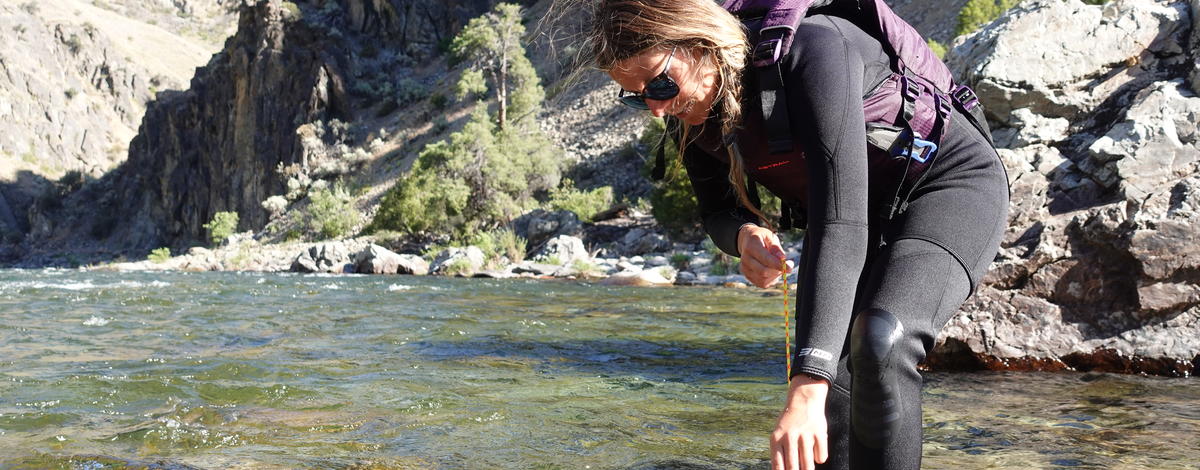Recent years have seen above-average hot summers and below-average rain and snow, leaving many to wonder how that affects wild trout populations in Idaho rivers. While tributary streams are important for spawning and also raising juvenile fish, these small streams may play a much bigger role in other ways.
The Middle Fork Salmon River is home to wild populations of Westslope cutthroat trout, bull trout, steelhead trout, Chinook salmon and other native fishes. This watershed is almost entirely within wilderness, offering a rare opportunity to study trout in a large, dynamic landscape with many interconnected tributaries. Biologists have been surveying fish populations here for decades, and this system continues to offer clues about how trout deal with low flows and hot summers.
Video: Middle Fork Salmon River Plumes
In 2012-2014 during their annual Middle Fork Salmon River snorkel surveys, Fish and Game biologists examined how trout might be using tributaries (read about this here). That research has expanded more recently and included more surveys in 2021 and 2022.

On the Middle Fork Salmon River, biologists stop and prepare to survey Pistol Creek, one of many tributaries that offer important habitat to native trout and salmon.
Many high elevation tributaries originate in snow-covered mountains and flow into the Middle Fork of the Salmon River in central Idaho. Most of these smaller tributaries have colder water temperatures than the mainstem Middle Fork Salmon River. As a result, some tributaries can form a small zone of cold-water, forming a “plume” downstream of the mouth where they join the main river.

As spawning and rearing habitat, tributary streams play important roles to migratory trout living in connected river systems. But they can also be important as a coldwater oasis during hot summers.
The plume of tributary water entering the warmer mainstem water can create a small coldwater oasis for fish species like Westslope cutthroat trout, bull trout, mountain whitefish, as well as juvenile salmon and steelhead. Counting the numbers of fish using the plumes helps inform biologists as to which species might be using them and how important certain tributaries might be to providing these coldwater refugia.

Biologists prepare for a “plume” snorkel survey, counting fish both above and below the mouth of a tributary to the Middle Fork Salmon River.
In this study, snorkelers counted fish both upstream of the plume (where there is likely no cold water mixing), and then again downstream of the tributary where the plume is located. They also monitored water temperatures to see how much difference there was in temperature between the main river above and below the plume, as well as the tributary itself.

Snorkel surveys counted fish both above, and below tributary “plumes” to evaluate how fish use them and the relative importance of coldwater sources.
In general, greater numbers of fish were observed below the mouths of tributaries in the plume than above. During years with relatively low water and high temperatures, this observation has been more distinct. For example, 2021 was a below-average water year where above-average water temperatures (65 degrees) were recorded. In that year, we found that 88% percent of fish counted in these surveys were located in the plumes. Contrast that with 2022 – a year with higher water levels and lower average water temperatures (62 degrees). Though we still found that plumes were important to fish, only 65 percent of fish were found using plumes. During times of increased thermal stress, it looks like fish are much more likely to seek out those sources of cold water.

Counts of Westslope cutthroat trout above and below tributary “plumes” corresponding to various water levels (gauge height) in different years.
Why are these findings so important? As the climate changes, many places are seeing hotter summers and warmer water temperatures, making the role of cold tributaries even more important for native trout. A variety of human activities and needs has reduced the number of fully connected tributaries to larger rivers.
In many watersheds, tributaries are often diverted for agriculture and drinking water. Some are disconnected from main rivers by dams, culverts and diversions. While water resources are important for people, connected tributaries are the migratory highways that connect a fish’s life cycle, and often provide an oasis of cold, clean, water during warm summer months.

